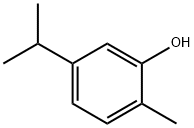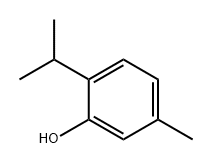Origanum oil
- CAS NO.:8007-11-2
- Molecular Weight: 0
- MDL number: MFCD00131768
- EINECS: 616-905-4
- SAFETY DATA SHEET (SDS)
- Update Date: 2024-12-18 14:07:02
What is Origanum oil?
Chemical properties
Origanum oils are produced from the flowering herb of Mediterranean Origanum
(Lamiaceae) species, mainly Origanum vulgare L. ssp. hirtum. Spanish origanum oil is derived from Coridothymus capitatus Rchb., syn. Thymbra
capitata (L.) Cav. The oils differ mainly in their content of carvacrol and thymol,
which are major constituents. Oil with a high carvacrol
content is a yellowish-red to dark brown liquid with a spicy, herbaceous
odor, reminiscent of thyme.The color quickly turns to blackwhen in contact with iron.
d2020 0.930–0.955; n20D 1.500–1.513; α20D ?5 ° to +2 °; solubility: 1 vol in ≤4 vol
of 70% ethanol; solutions may become opalescent. Composition: ??-terpinene
3.5–10%; p-cymene 5.5–9%, thymol 0–5%, carvacrol 60–75% (Spanish type).
Annually, some 10 t each of Spanish origanum oil and of O. vulgare oil are produced,
the latter mainly in Hungary. Origanum oils are used in perfume compositions
for herbal, spicy, leathery notes and in seasoning mixtures.
Chemical properties
Mexican oregano is, for all practical purposes, organoleptically indistinguishable from the species Origanum vulgare L. or Coleus ambionica. Thus, the name oregano is a general term applying to a particular herb flavor, rather than to a particular species of plant. Oregano is a perennial herb that is either common or wild and is a vigorous grower with oval leaves on stems up to 30 in. high. It has purple flowers that appear in late summer. The part used is the leaf.
Occurrence
Found in the herb Thymus capitatus Hoffmgg. et Link and various other species of Origanum (Fam. Labiatae).
Preparation
By steam distillation of the flowering herb.
Definition
Extractives and their physically modified derivatives. Thymus capitatus, Labiatae.
Essential oil composition
Screening of antimicrobial activity compounds in Lippia graveolens showed that most of compounds were flavonoids mono- and dihydroxylated in the B ring.* Volatile oil from oregano contains carvacrol.
Safety Profile
Poison by skin contact. Moderately toxic by ingestion. A severe skin irritant. When heated to decomposition it emits acrid smoke and irritating fumes. See also CARVACROL
Properties of Origanum oil
| Boiling point: | 239 °C (lit.) |
| Density | 0.939 g/mL at 25 °C (lit.) |
| refractive index | n |
| FEMA | 2828 | ORIGANUM OIL (EXTRACTIVE) (THYMUS CAPITATUS L. HOFFMANNS & LINK) |
| Flash point: | 147 °F |
| form | clear liquid |
| color | Yellow to dark red-brown liquid |
| Odor | pungent spicy odor of thyme oil |
| Merck | 14,6807 |
| CAS DataBase Reference | 8007-11-2 |
| EPA Substance Registry System | Oils, origanum (8007-11-2) |
Safety information for Origanum oil
| Signal word | Danger |
| Pictogram(s) |
 Skull and Crossbones Acute Toxicity GHS06 |
| GHS Hazard Statements |
H302:Acute toxicity,oral H311:Acute toxicity,dermal H315:Skin corrosion/irritation H319:Serious eye damage/eye irritation |
| Precautionary Statement Codes |
P280:Wear protective gloves/protective clothing/eye protection/face protection. P312:Call a POISON CENTER or doctor/physician if you feel unwell. P305+P351+P338:IF IN EYES: Rinse cautiously with water for several minutes. Remove contact lenses, if present and easy to do. Continuerinsing. |
Computed Descriptors for Origanum oil
New Products
(S)-3-Aminobutanenitrile hydrochloride 4-Methylphenylacetic acid N-Boc-D-alaninol N-BOC-D/L-ALANINOL Tert-butyl bis(2-chloroethyl)carbamate N-octanoyl benzotriazole 3-Morpholino-1-(4-nitrophenyl)-5,6-dihydropyridin- 2(1H)-one Furan-2,5-Dicarboxylic Acid S-2-CHLORO PROPIONIC ACID ETHYL ISOCYANOACETATE 2-Bromo-1,3-Bis(Dimethylamino)Trimethinium Hexafluorophosphate 4-IODO BENZOIC ACID 3-NITRO-2-METHYL ANILINE 1-(2,4-DICHLOROPHENYL) ETHANAMINE (2-Hydroxyphenyl)acetonitrile 4-Bromopyrazole 5,6-Dimethoxyindanone 2-(Cyanocyclohexyl)acetic acid 4-methoxy-3,5-dinitropyridine 1-(4-(aminomethyl)benzyl)urea hydrochloride 2-aminopropyl benzoate hydrochloride diethyl 2-(2-((tertbutoxycarbonyl)amino) ethyl)malonate tert-butyl 4- (ureidomethyl)benzylcarbamate Ethyl-2-chloro((4-methoxyphenyl)hydrazono)acetateRelated products of tetrahydrofuran
You may like
-
 Oil of Origanum CAS 8007-11-2View Details
Oil of Origanum CAS 8007-11-2View Details
8007-11-2 -
 Origanum oil, FCC CAS 8007-11-2View Details
Origanum oil, FCC CAS 8007-11-2View Details
8007-11-2 -
 Oil of Origanum CASView Details
Oil of Origanum CASView Details -
 1975-50-4 98%View Details
1975-50-4 98%View Details
1975-50-4 -
 2-HYDROXY BENZYL ALCOHOL 98%View Details
2-HYDROXY BENZYL ALCOHOL 98%View Details
90-01-7 -
 2-Chloro-1,3-Bis(Dimethylamino)Trimethinium Hexafluorophosphate 221615-75-4 98%View Details
2-Chloro-1,3-Bis(Dimethylamino)Trimethinium Hexafluorophosphate 221615-75-4 98%View Details
221615-75-4 -
 14714-50-2 (2-Hydroxyphenyl)acetonitrile 98+View Details
14714-50-2 (2-Hydroxyphenyl)acetonitrile 98+View Details
14714-50-2 -
 118753-70-1 98+View Details
118753-70-1 98+View Details
118753-70-1



